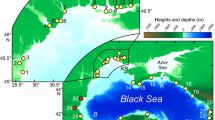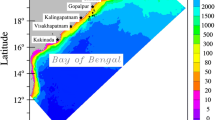Abstract
The Patos Lagoon is a choked, microtidal coastal laggon situated in southern Brazil between 30°S and 32°S. The response of the lagoon to tidal oscillations is studied through data analysis and numerical modeling experiments. Two types of high frequency oscillations are observed in the tidal frequency band: mixed tides, predominantly diurnal; and forced oscillations having a period of 24 h occurring in the inner lagoon. In the southern portion of the lagoon, tides are selectively filtered by the entrance channel. The main diurnal constituent O1 is linearly attenuated as it progresses landwards. In the inner parts of the lagoon, 24-h oscillations are mainly forced by the combined effect of diurnal tides and sea breeze action. They are tied with a natural period of oscillation of 24 h. Results also indicate that these are not inertial frequency oscillations, despite the lagoon being placed in a critical 30°S area. The interaction between astronomical tides and meteorological effects produces a complicated picture for tidal forecasting derived from data collected inside the lagoon.
Similar content being viewed by others
Literature Cited
Almeida, L. E., N. L. Rosauro, andL. A. M. Endres. 1992. Banco de Dados de Níveis e Ventos da Lagoa dos Patos. Technical Report, Instituto de Pesquisas Hidráulicas (IPH), Volume I. Universidade Federal do Rio Grande do Sul (UFRGS), Porto Algegre, Rio Grande do Sul.
Asmus, H. W. 1989. Ecologia, dinâmica e funcionamento do sistema lagunar Patos. Technical Report contract Comissão Interministerial para os Recursos do Mar (CIRM)/Fundação Universidade Federal do Rio Grande (FURG), Rio Grande, Rio Grande do Sul.
Audrey, D. G. andP. E. Speer. 1985. A study of non-linear tidal propagation in shallow inlet/estuarine systems. Part I: Observations.Estuarine Coastal and Shelf Science 21:185–206.
Azevedo, J. R. 1945. Influência das variações da pressão atmosférica sobre as oscilações de nível d’ água do Guaiba. Revista de Engenharia do Rio Grande do Sul, Porto alegre, Brasil.
Boon, J. D. 1975. Tidal discharge asymmetry in a salt marsh drainage system.Limnology and Oceanography 20:71–80.
Chen, C., R. O. Reid, andW. D. Nowlin Jr. 1996. Near-inertial oscillations over the Texas-Louisiana shelf.Journal of Geophysical Research 101:3509–3524.
Coimbra, R. M., L. C. H. Ferreira, R. Dewes, and J. L. Marques. 1983. Mecânica das Correntes do Guaíba. Departamento Nacional de Águas e Energia Elétrica (DNAEE), Ministério de Minas e Energia, Technical Report, Brasília, Brazil.
Costa, C., U. Seeliger, andP. Kinas. 1988. The effect of wind velocity and direction on the salinity regime in the lower Patos Lagoon estuary.Ciência e Cultura 40:909–912.
Cushman-Roisin, B., A. J. Willmott, andN. R. T. Biggs. 2005. Influence of stratification on decaying surface seiche modes.Continental Shelf Research 25:227–242.
Defant, F. 1961. Physical Oceanography, Volume II. Pergamon Press, London, England.
Diretoria de Hidrografia e Navegação. 1966. Brasil Costa Sul-da Ilha de Santa Catarina a Maldonado, Nautical Chart 90, 2nd edition. Diretoria de Hidrografia e Navegação, Niterói, Rio de Janeiro.
Diretoria de hidrografia e Navegação. 1968. Brasil Costa Sul—Lagoa dos Patos, Nautical Chart 2140, 2nd edition. Diretoria de Hidrografia e Navegação, Niterói, Rio de Janeiro.
Fernandes, E. H. L., I. Mariño-Tapia, K. R. Dyer, andO. O. Mőller. 2004. The attenuation of tidal and subtidal oscillations in the Patos Lagoon estuary.Ocean Dynamics 54:348–359.
Friedrichs, C. T. andO. S. Madsen. 1992. Nonlinear diffusion of the tidal signal in frictionally dominated embayments.Journal of Geophysical Research 97:5637–5650.
Godin, G. 1986. Is the abnormal response of the tide at the frequency of S2 really due to radiational effects?Continental Shelf Research 6:615–625.
Godin, G. 1989. On “radiational” tides and their interpretation as frictional effects.Continental Shelf Research 9:589–596.
Herz, R. 1977. Circulação das Águas de Superfície da Lagoa dos Patos. DSc. Dissertation, University São Paulo, Brazil.
Hill, A. E. 1994. Fortnightly tides in a lagoon with variable choking.Estuarine Coastal and Shelf Science 38:423–434.
Hsu, S. A. 1985. Correction of land-based wind data for offshore applications: A further evaluation.Journal of Physical Oceanography 16:390–394.
Isaji, T., M. L. Spaulding, andJ. Stace. 1985. Tidal exchange between a coastal lagoon and offshore waters.Estuaries 8:203–216.
Kjerfve, B. andB. A. Knoppers. 1989. Tidal choking in a coastal lagoon, p. 167–179.In B. Parker (ed.), Tidal Hydrodynamics. John Willey and Sons, New York.
Lazure, P. 1992. Etude de la dynamique de l’étang de Thau par modele numérique tridimensionnel.Vie et Millieu 42:137–145.
Lazure, P. andJ.-C. Salomon. 1991. Coupled 2D and 3D modelling of coastal hydrodynamics.Oceanologica Acta 14:173–180.
Lizitzin, E. 1974. Sea Level Changes. Elsevier Oceanography Series 8, Amsterdam, The Netherlands.
Lorenzzetti, J. A. 1976. Aplicação da Técnica de Análise Espectral Cruzada ao Estudo da Correlaçõ entre as Oscilações de Nível do Mar Observadas em Cananéia e Bom Abrigo. M.Sc. Thesis, University São Paulo, São Paulo, Brazil.
Malaval, M. B. 1922. Travaux du Port et de la Barre de Rio Grande, Brésil. Mémoire, Eyrolles Editeurs, Paris, France.
Mőller, O. O. 1996. Hidrodynamique de la lagunes dos Patos. Mesures et Modélisation. DSc. Dissertation, University Bordeaux I, Bordeaux, France.
Mőller, O. O. andP. Castaing. 1999. Hydrographical characteristics of the Patos lagoon estuarine area, p. 83–100.In G. Perillo, M. C. Piccolo, and M. Pino (eds.), Estuaries of South America. Springer, Berlin, Germany.
Mőller, O. O., P. Castaing, J._C. Salomon, andP. Lazure. 2001. The influence of local and nonlocal forcing effects on the subtidal circulation of Patos Lagoon.Estuaries 24:297–311.
Mőller, O. O., J. A. Lorenzzetti, J. L. Stech, andM. M. Mata. 1996. The summertime circulation and dynamics of Patos Lagoon.Continental Shelf Research 16:335–351.
Mőller, O. O., P. S. Paim, andI. D. Soares. 1991. Facteurs et mecanismes de la circulation des eaux dans l’estuaire de la lagune dos Patos.Bulletin Institut de Géologie du Bassin d’Aquitaine 49:15–21.
Motta, V. F. 1969. Relatório diagnóstico sobre a melhoria e o aprofundamento do canal de acesso pela barra do Rio Grande. Technical Report. Instituto de Pesquisas Hidráulicas (IPH), Universidade Federal do Rio Grande do Sul (UFRGS), Porto Alegre, Rio Grande do Sul.
Parker, B. B. 1991. The relative importance of the various nonlinear mechanisms in a wide range of tidal interactions (review), p. 237–268.In B. Parker (ed.), Tidal Hydrodynamics. John Wiley and Sons, New York.
Prandle, D. 1985. Classification of tidal response in estuaries from channel geometry.Geophysical Journal of the Royal Astronomical Society 80:209–221.
Rosauro, N. M. L. 1986a. Seiches e suas ocorrências na Lagoa dos Patos e Rio Guaiba (RS-Brasil).Revista Brasileira de Engenharia 4:73–89.
Rosauro, N. M. L. 1986b. Simulação de seiches induzidas por vento e pressão atmosférica utilizando-se de um modelo em elementos finitos.Revista Brasileira de Engenharia 4:73–90.
Rosauro, N. M. L. andL. A. M. Endres. 1991. Statistical analysis of water level and wind data at the Patos Lagoon.Anais do IX Simpósio Brasileiro de Recursos Hídricos IV:477–486.
Salomon, J.-C. andG. Allen. 1983. Role sedimentologique de la marée dans les estuaires a fort marnage.Notes and Memoires 18:35–44.
Scarlatos, P. D. 1993. Tidal energy in well-mixed estuaries.Journal of Coastal Research 9:907–914.
Schiwederski, E. W. 1979. Global Ocean Tides, Part II: The semidiurnal principal lunar tide (M2). Atlas of tidal charts and maps. Technical Report, U.S. Naval Surface Weapons Center NSWC-TR, 79-414, Dahlgreen, Virginia.
Simon, B. 1979. Marée en Gironde. Technical Report 273, Etablissement Principal du Service Hydrographique et Océanographique de la Marine (EPSHOM), Brest, France.
Simpson, J. H., P. Hyder, T. P. Rippeth, andI. M. Lucas. 2002. Forced oscillations near critical latitude for diurnal-inertial resonance.Journal of Physical Oceanography 32:177–187.
Smith, N. P. 1977. Meteorological and tidal exchanges between Corpus Christi Bay, Texas, and the Northwestern Gulf of Mexico.Estuarine and Coastal Marine Science 5:511–520.
Smith, N. P. 1980. A comparison of tidal harmonic constants computed at and near an inlet.Estuarine and Coastal Marine Science 10:383–391.
Vassie, J. 1982. Tides and low frequency variations in the equatorial Atlantic.Oceanologica Acta 5:3–6.
Walters, R. A. andF. W. Werner. 1991. Non linear generation of overtides, compound tides and residuals, p. 297–321.In B. Parker (ed.), Tidal Hydrodynamics, John Wiley and Sons, New York.
Wang, J. D. andJ. J. Connor. 1975. Mathematical modeling of near coastal circulations. Technical Report. 200, R. M. Parsons Laboratory Massachusetts Institute of Technology, Cambridge, Massachusetts.
Wong, K.-C. andJ. H. Throwbridge. 1990. Some observational evidence on the effect of atmospheric forcing on tidal variability in the upper Delaware Bay.Journal of Geophysical Research 95:16229–16240.
Author information
Authors and Affiliations
Corresponding author
Rights and permissions
About this article
Cite this article
Möller, O.O., Castaing, P., Fernandes, E.H.L. et al. Tidal frequency dynamics of a Southern Brazil coastal lagoon: Choking and short period forced oscillations. Estuaries and Coasts: JERF 30, 311–320 (2007). https://doi.org/10.1007/BF02700173
Received:
Revised:
Accepted:
Issue Date:
DOI: https://doi.org/10.1007/BF02700173




